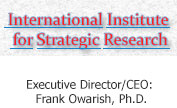by Frank Owarish Ph.D. CEO, IISRT and Justine Gross, Research Associate, IISRT
(International Institute for Strategic Research and Training, NYS registered think tank, independent nonprofit academic organization)
http://internationalinstituteforstrategicresearch.info/
Foreword: I had a conversation with Justine who was preparing a paper on Hunger; she was surprised by the scale of hunger in the USA and in so many countries of the world. She added that food aid is useful but is of a short term nature and that efforts should be made to build up the needed infrastructure to produce; she reminded me of the Chinese proverb which states that ‘give a man a fish and he will have something to eat’; ‘show a man how to fish and he will be able to provide food for his family and even community’ and I added, show the man how to teach members of his community to fish and there will be a multiplier effect. At the United Nations, I promoted the concept of training of trainers at a time when countries needed to develop human resources, and I served as Coordinator of an Inter-regional Workshop on the subject aimed at human resource development of all developing countries at the time. I often mention the example of South Korea going from the status of a developing country to a world power on hi-tech. Back to water and food. For the US, we shall set up a web site to raise awareness about hunger in America and show efforts being made to deal with that complex issue.
Strategic research compilation
We are in the year 2022 hoping for the best compared to 2021 and 2020, a lost year with lockdown and other setbacks. Countries of the world are still dealing with the pandemic.
Water is a very important commodity and will likely be even more so in the coming years.
There is largescale hunger in many countries; lack of food and lack of water. Leaders of the affected countries should engage in bilateral cooperation with those in countries with technological knowhow and work with international organizations such as the Word Bank and UNDP to bridge the gap and turn the situation around. Hydroponic technology has been around for many years with drip irrigation; small area and small amount of water and such projects can be replicated in large number.
Pipelines are not expensive to build and can carry water from water rich regions including rivers to the deprived areas and a variety of fruits and vegetables can be grown and used for local consumption. With water, farming can be developed and animals raised and fish can be grown in ponds or even tanks.
For areas low on rain, airplanes can be used to spread silver oxide on the clouds fostering rain.
At another level, desalination technology has also been successfully used in the recent years. A good example is Australia. A higher level of investment is needed and there are some drawbacks which have to be dealt with. Most of the Earth consist of oceans; there is water everywhere. Again, desalination plants and pipelines are the answers.
“An enormous amount of human talent is being wasted by poverty and malnutrition” (Sam Owarish). Those poor people, transformed, can help themselves and contribute to economic and social development of their community.
Useful background information: Water, Food and Energy
Climate change is here: look at megadrought: https://www.msn.com/en-us/news/us/the-intense-dry-spell-in-the-west-is-worst-megadrought-in-1-200-years-new-study-says/ar-AATQYdV?ocid=msedgdhp&pc=U531
Farming breakthroughs:
Living with the Land Greenhouse Epcot Walt Disney World https://www.youtube.com/watch?v=3e8ZNseRe0I
Growing vegetables https://www.msn.com/en-us/health/nutrition/9-vegetables-you-can-easily-regrow-from-scraps/ss-AASIkPf?ocid=msedgdhp&pc=U531
Growing an avocado plant https://www.msn.com/en-us/lifestyle/home-and-garden/it-s-so-easy-to-grow-an-avocado-plant/ar-AASG1iD?ocid=msedgdhp&pc=U531
Next Gen Farming https://www.youtube.com/watch?v=3Ww2TP_tU7o
Story of the youngest farmer (made the news) https://abcnews.go.com/GMA/Living/year-makes-history-georgias-youngest-farmer/story?id=80422154
Vertical farming (Google) Beyond providing fresh local produce, vertical agriculture could help increase food production and expand agricultural operations as the world’s population is projected to exceed 9 billion by 2050. And by that same year, two out of every three people are expected to live in urban areas. August 2, 2021
Case study in vertical farming https://dailyhive.com/vancouver/downtown-vancouver-rooftop-garden-first-of-its-kind-in-north-america
Turning desert into farms https://www.msn.com/en-us/news/technology/genetic-goldmine-in-earth-s-harshest-desert-could-be-the-key-to-feeding-the-future/ar-AAQdocH?ocid=msedgdhp&pc=U531
Great green wall brings life back to Niger desert: https://www.msn.com/en-us/news/world/great-green-wall-brings-life-back-to-niger-desert/ar-AAR1eaa?ocid=msedgdhp&pc=U531
Water pipeline:
Case study water pipeline https://www.eenews.net/articles/as-the-west-bakes-utah-forges-ahead-with-water-pipeline/
Water pipeline network which also eliminate flooding https://www.change.org/p/end-floods-in-america-by-creating-a-pipeline-network-to-shift-flood-waters-to-drought-stricken-areas
Desalination:
Seawater desalination success, a comprehensive look by Nikhilesh Mukherjee https://thewaternetwork.com/_/desalination/blog-Jl6/seawater-desalination-success-story-KFfWfA709dzATFKXOLurTw
Ocean water desalination not an easy solution; possible to reduce the drawbacks https://healthebay.org/sites/default/files/Desalination%20FAQ%20Sheet_final.pdf
Water resource management and sustainability, case study The Republic of Maldives file:///C:/Users/corin/Downloads/sustainability-13-03484-v2.pdf
Important considerations (Sam Owarish, Ph.D., Engineering)
“Brass Tacks:
Rich countries like Australia and Israel have the project management skills required for such projects. The mineral content of the water needs to be analyzed so as not to kill the fertility of the soil. Gravity is not always enough to move the water. Pumping stations along the pipelines are required to push the water as it is heavy. Maintenance of the equipment is necessary. An organization to overseer the projects on a global basis is required. Financing the poorer counties is also required.”
Fishing:
A coastal pond or tidal trap, first used for inshore fishing by Stone Age peoples.
1959 J.D. Clark Prehist. of S. Afr. 131At various points ranging for over a thousand miles of coast are enclosures and dams known as vywers. Some..are still in use and are or were ground-baited…It seems probable that this method of inshore fishing dates back to these times…The ‘Mermaid’ scene from a painted rock shelter at Ezeljachtspoort..may well represent a fishing group at one of these vywers.
1992 Yeld & Gubb in Afr. Wildlife Vol.46 No.2, 200At some point in their ancient history they (sc. the Strandlopers) stumbled on the idea of building tidal fish traps, or vywers as they later came to be known.
Significant efforts worthy of attention:
Southern Madagascar https://www.bbc.com/news/world-africa-59595276




